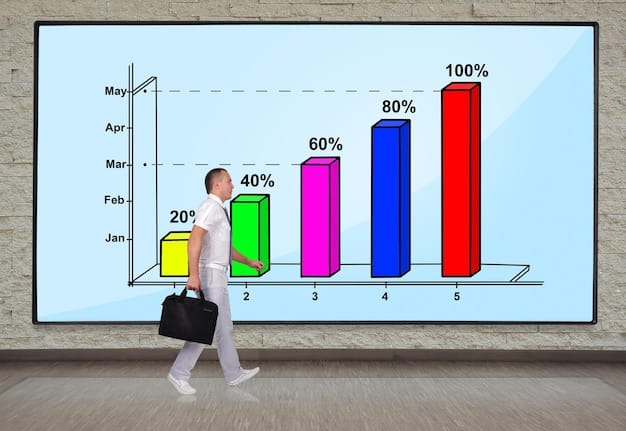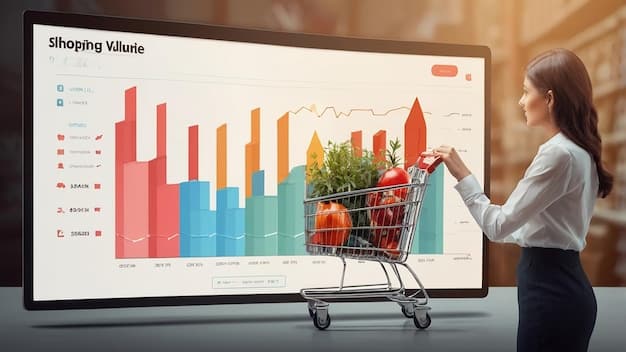E-commerce Conversion Rate Optimization in 2025: Boost Your Sales

E-commerce Conversion Rate Optimization: Turning Website Visitors into Paying Customers in 2025 is crucial for online businesses. By focusing on user experience, mobile optimization, and data analytics, e-commerce stores can significantly improve their conversion rates and boost sales.
Are you looking to improve your e-commerce conversion rates and turn more website visitors into paying customers? In the ever-evolving world of online retail, mastering e-commerce conversion rate optimization: turning website visitors into paying customers in 2025 is more critical than ever. Understanding the latest strategies and technologies is key to staying ahead of the competition.
This article will explore actionable tips and techniques to optimize your e-commerce site for higher conversions, ensuring you’re well-prepared for the future of online shopping. Let’s dive in and discover how to make the most of your website traffic!
Understanding E-commerce Conversion Rate Optimization
E-commerce Conversion Rate Optimization: Turning Website Visitors into Paying Customers in 2025 is the process of enhancing your online store to increase the percentage of visitors who complete a desired action, such as making a purchase. This involves analyzing user behavior, identifying pain points, and implementing changes to improve the overall shopping experience.
Let’s explore why this topic is so crucial for any online business.
What Is a Good E-commerce Conversion Rate?
A “good” e-commerce conversion rate typically falls between 1% and 3%. However, this can vary depending on the industry, product type, and target audience. Aiming for the higher end of this range or even exceeding it through effective optimization efforts should be the target.
Why Is Conversion Rate Optimization Important?
Conversion rate optimization is essential because it directly impacts your revenue. By converting more visitors into customers, you maximize your return on investment (ROI) from marketing efforts and website traffic. It also helps in understanding customer behavior, allowing you to tailor your offerings for better engagement.
- Maximizes ROI from marketing campaigns
- Improves customer understanding and engagement
- Increases overall revenue and profitability
In conclusion, understanding and implementing effective e-commerce conversion rate optimization: turning website visitors into paying customers in 2025 techniques can significantly boost your online business’s performance. This involves continuous monitoring, analysis, and adaptation to meet evolving customer needs.

Enhancing User Experience for Higher Conversions
User experience (UX) plays a vital role in e-commerce conversion rate optimization: turning website visitors into paying customers in 2025. A seamless and enjoyable experience encourages visitors to explore products, add items to their cart, and complete their purchase. Usability, site speed, and intuitive navigation are key elements.
Let’s examine some actionable steps you can take to enhance UX.
Streamlining Navigation and Site Search
Make sure your website navigation is intuitive and easy to use. Implement clear categories and subcategories, and ensure the site search function is accurate and efficient. A well-organized site helps users find what they need quickly.
Optimizing Product Pages
High-quality product images, detailed descriptions, and customer reviews are crucial for product pages. Include multiple angles of the product, highlight key features, and provide social proof through reviews and ratings. Clear call-to-action buttons should also be prominently displayed.
- Use high-quality product images and videos
- Write detailed and compelling product descriptions
- Incorporate customer reviews and ratings
Enhancing user experience through streamlined navigation and optimized product pages can significantly improve e-commerce conversion rate optimization: turning website visitors into paying customers in 2025. By focusing on these aspects, you can create a more engaging and user-friendly environment that encourages purchases.
Mobile Optimization Is Key
With the increasing use of smartphones for online shopping, mobile optimization is a must for e-commerce conversion rate optimization: turning website visitors into paying customers in 2025. A mobile-friendly website ensures a smooth and consistent experience for users on any device.
Let’s get into the reasons mobile optimization is so critical in e-commerce.
Responsive Design Implementation
Use a responsive design that automatically adjusts your website layout to fit different screen sizes. This ensures that your site looks and functions well on smartphones, tablets, and desktops. Prioritize mobile-first design to cater to the majority of your audience.
Mobile-Friendly Checkout Process
Simplify the checkout process for mobile users by minimizing form fields, offering guest checkout options, and providing secure payment options like mobile wallets. A streamlined checkout experience reduces friction and increases conversion rates.
- Implement responsive design for all devices
- Simplify the mobile checkout process
- Offer mobile-friendly payment options
Prioritizing mobile optimization is essential for e-commerce conversion rate optimization: turning website visitors into paying customers in 2025. By focusing on responsive design and a simplified checkout process, you can provide a better mobile shopping experience, leading to higher conversion rates and increased sales.
Leveraging Data Analytics for Conversion Insights
Data analytics provides valuable insights into user behavior, helping you understand how visitors interact with your website. By tracking key metrics and analyzing data, you can identify areas for improvement and make informed decisions to boost e-commerce conversion rate optimization: turning website visitors into paying customers in 2025.
Let’s look at how data analytics can drive conversion improvements:
Tracking Key Performance Indicators (KPIs)
Monitor essential KPIs such as bounce rate, time on page, cart abandonment rate, and conversion rate. These metrics provide a clear picture of your website’s performance and help you pinpoint areas that need attention. Use analytics tools to track these KPIs accurately.
Using A/B Testing
A/B testing involves comparing two versions of a webpage or element to see which performs better. Test different headlines, call-to-action buttons, images, and page layouts to identify the most effective variations. A/B testing allows you to make data-driven decisions and optimize your website for better conversions.
- Monitor KPIs like bounce rate and cart abandonment
- Conduct A/B tests to optimize page elements
- Use data-driven insights to inform decisions
Leveraging data analytics is crucial for e-commerce conversion rate optimization: turning website visitors into paying customers in 2025. By tracking KPIs and using A/B testing, you can gain valuable insights into user behavior and optimize your website for higher conversions and increased revenue.

Personalization and Customer Engagement Strategies
Personalization and customer engagement are important factors in e-commerce conversion rate optimization: turning website visitors into paying customers in 2025. Tailoring the shopping experience to individual preferences and engaging customers through personalized communication can significantly boost conversion rates.
Here’s how you can personalize your customer’s experience to drive conversions.
Personalized Product Recommendations
Implement personalized product recommendations based on browsing history, past purchases, and customer demographics. Use recommendation engines to suggest relevant products that are likely to interest each individual shopper. Personalized recommendations can increase click-through rates and drive sales.
Email Marketing Automation
Use email marketing automation to send personalized messages based on customer behavior. Create automated email sequences for abandoned carts, welcome emails for new subscribers, and promotional offers based on past purchases. Personalized emails can re-engage customers and drive conversions.
- Implement personalized product recommendations
- Use email marketing automation for targeted communication
- Offer personalized promotions and discounts
Personalization and customer engagement strategies are vital for e-commerce conversion rate optimization: turning website visitors into paying customers in 2025. By personalizing product recommendations and using email marketing automation, you can create a more engaging and relevant shopping experience, leading to higher conversion rates and increased customer loyalty.
Future Trends in E-commerce Conversion Rate Optimization
As technology advances, future trends in e-commerce conversion rate optimization: turning website visitors into paying customers in 2025 will focus on AI-driven personalization, immersive shopping experiences, and seamless omnichannel integration. Staying ahead of these trends will be essential for maintaining a competitive edge.
Now, let’s discuss ways to get ahead of the trends for the future of e-commerce.
AI-Driven Personalization
Artificial intelligence (AI) will play an even greater role in personalization, with AI-powered recommendation engines analyzing vast amounts of data to provide highly relevant product suggestions. AI chatbots will also offer instant customer support and personalized assistance, enhancing the shopping experience.
Immersive Shopping Experiences
Augmented reality (AR) and virtual reality (VR) technologies will create immersive shopping experiences, allowing customers to virtually try on clothes, visualize furniture in their homes, and interact with products in a more engaging way. These immersive experiences will drive higher conversion rates and increase customer satisfaction.
- Implement AI-powered personalization for product recommendations
- Integrate AR and VR technologies for immersive shopping
- Focus on seamless omnichannel integration
Staying informed and adopting future trends in e-commerce conversion rate optimization: turning website visitors into paying customers in 2025 will be crucial for maintaining a competitive edge. AI-driven personalization and immersive shopping experiences will revolutionize the way customers shop online, driving higher conversion rates and customer loyalty.
| Key Point | Brief Description |
|---|---|
| 🚀 UX Enhancement | Improving user experience through intuitive navigation. |
| 📱 Mobile Optimization | Ensuring a seamless mobile shopping experience. |
| 📊 Data Analytics | Using data to understand and improve conversions. |
| 🤖 AI Personalization | Leveraging AI for personalized recommendations. |
Frequently Asked Questions
E-commerce Conversion Rate Optimization: Turning Website Visitors into Paying Customers in 2025 is about improving your online store so more visitors make a purchase. This involves analyzing user behavior and making data-driven improvements for a better shopping experience.
Mobile optimization is crucial because many users shop on smartphones. A mobile-friendly site ensures a seamless experience, leading to higher conversion rates and more satisfied customers, boosting your overall sales.
Data analytics provides insights into user behavior. By tracking key metrics like bounce rate and cart abandonment, you can identify areas for improvement and make informed decisions, which is key to e-commerce conversion rate optimization: turning website visitors into paying customers in 2025.
A good e-commerce conversion rate typically ranges from 1% to 3%. However, it varies by industry and product type. Continuously optimizing your site to reach or exceed this range should be your target goal.
AI will enhance personalization through better product recommendations and customer service. This means you can offer tailored shopping experiences, leading to increased conversions. AI will be a major component of e-commerce conversion rate optimization: turning website visitors into paying customers in 2025.
Conclusion
In conclusion, mastering e-commerce conversion rate optimization: turning website visitors into paying customers in 2025 involves a multifaceted approach, focusing on user experience, mobile optimization, data analytics, and personalization. By implementing these strategies, you can significantly improve your conversion rates and drive revenue.
Staying informed about future trends, such as AI-driven personalization and immersive shopping experiences, will be crucial for maintaining a competitive edge in the evolving e-commerce landscape. Embrace these strategies to ensure your online store thrives.





